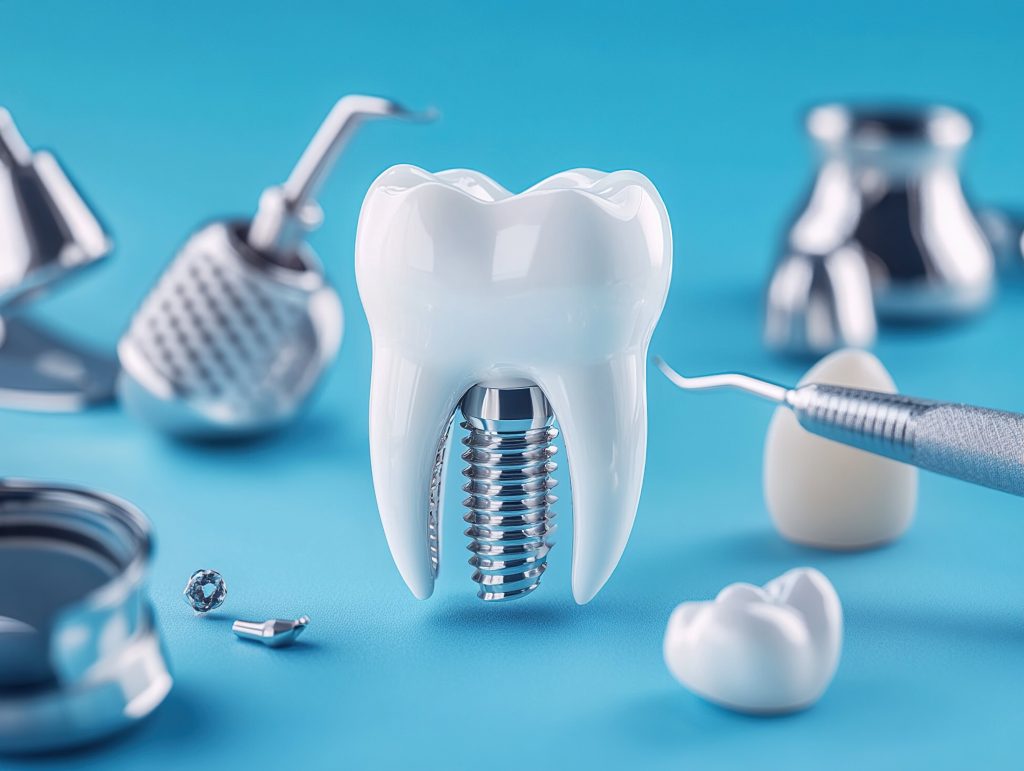Tooth loss is more than a cosmetic concern. Missing teeth can lead to shifting bite patterns, bone loss, gum disease, and difficulties with speech and eating. Modern implant dentistry provides advanced dental implant solutions that restore natural teeth function while improving confidence and oral health.
This in-depth guide explains the different types of dental implants, the dental implant procedure from start to finish, and how to choose the right implant option for your needs. You’ll also learn about immediate load implants, bone grafting procedures, implant supported bridges, and full arch dental implants. By the end, dental implants are explained in full detail so you can approach your initial consultation with clarity and confidence from expert dental implant services.
Why Dental Implants Matter
Tooth replacement is not only about aesthetics. Replacement teeth supported by implants preserve bone density, prevent neighboring teeth from shifting, and maintain gum tissue health. Unlike removable dentures or traditional dental bridges, implants mimic the natural tooth root, keeping the jawbone stimulated and preventing long-term bone loss.
Patients missing or damaged teeth often discover that dental implants provide a permanent solution. Whether you need a single tooth implant or an entire arch restored with four dental implants, this treatment has helped countless patients restore both function and appearance.
How Dental Implant Surgery Works
Every dental implant procedure begins with an initial consultation. The dentist evaluates bone density, gum tissue health, and oral health history. Patients may need X-rays or 3D imaging to check whether there is enough healthy jawbone to hold implants securely.
If there is severe bone loss, bone augmentation or bone grafting may be required before the implant heals. For patients with enough bone, the process moves directly into surgery. During the procedure, a titanium or zirconia post is placed in the jaw to act as a tooth root. Once integration occurs, a dental crown, implant supported bridge, or full arch prosthetic is attached, resulting in permanent replacement teeth that look and function like real teeth.
Types of Dental Implants
Endosteal Implants
Endosteal implants are the most widely used type of dental implant. These traditional implants are surgically inserted into the jawbone. After the implant heals, a permanent crown, single implant, or implant supported bridge is placed.
- Best for: Patients with healthy jawbone and enough bone structure.
- Benefits: High success rate, long-lasting, supports single tooth or multiple tooth replacement.
- Considerations: Requires adequate bone density; may involve undergoing bone grafting if bone loss is present.
Subperiosteal Implants
Subperiosteal implants sit on top of the bone but beneath gum tissue. They are used when patients do not have enough healthy jawbone and prefer not to undergo bone grafting procedures.
- Best for: Patients with shallow jawbones or those who cannot undergo bone augmentation.
- Benefits: Less invasive for compromised bone.
- Considerations: Lower long-term success compared to endosteal implants.
Zygomatic Implants
Zygomatic implants are an advanced dental implant solution for patients with severe bone loss in the upper jaw. Instead of anchoring into the jawbone, these implants secure into the zygomatic bone (cheekbone).

- Best for: Patients with extensive upper jaw bone loss who cannot support traditional implants.
- Benefits: Avoids multiple bone grafting procedures.
- Considerations: Complex procedure, performed only by highly trained surgeons.
Modern Implant Solutions
All-on-4 and All-on-6 Systems
Full arch dental implants, commonly called All-on-4 or All-on-6, replace an entire set of upper or lower teeth using four dental implants or six implants per arch.
- Benefits: Provides a permanent solution for multiple missing teeth.
- Immediate load implants allow patients to leave with temporary teeth the same day.
- Long-term outcome: Once healed, a permanent crown or full arch prosthetic delivers the look and function of natural teeth.
Mini Dental Implants
Mini dental implants are smaller in diameter than traditional implants. They are often used for stabilizing removable dentures or replacing single teeth in patients with limited bone.
- Benefits: Less invasive surgery, faster recovery, lower cost.
- Limitations: Shorter lifespan than traditional implants, may not support heavy biting force.
- Common uses: Temporary tooth replacement or support for false teeth.
Emerging and Advanced Options
Root-Analogue Implants
Root-analogue implants are custom-shaped to replicate the exact shape of a natural tooth root. They are inserted immediately after extraction, reducing healing time and surgery steps. While not yet mainstream, they represent the future of implant dentistry.
Immediate Load Implants
Sometimes called “same-day implants,” immediate load implants allow placement of a temporary crown or bridge on the same day as dental implant surgery. This option provides instant function and appearance, though success depends on bone quality and gum tissue health.
Implant Materials: Titanium vs Zirconia
- Titanium: The most common material, biocompatible, strong, and proven over decades.
- Zirconia: A ceramic option that blends seamlessly with cosmetic dentistry treatments. Preferred by patients who want a metal-free solution.
Factors in Choosing the Right Implant Option
Each patient’s situation is unique. Here are the main factors considered during an implant consultation:
- Extent of tooth loss: Missing or damaged teeth may require a single implant, implant supported bridge, or full arch implants.
- Bone structure: Severe bone loss may require bone augmentation or zygomatic implants.
- Oral health: Periodontal disease and untreated tooth decay must be addressed first.
- Patient goals: Some want a permanent solution, others prefer quicker recovery with mini implants.
- Budget and lifestyle: Advanced procedures like zygomatic implants cost more than mini dental implants.
Working with providers specializing in expert dental implant services helps patients find the option that matches their health, expectations, and budget.
Risks and Healing
Every dental implant procedure carries risks, though complications are rare when performed by skilled surgeons. Potential issues include infection, nerve injury, or implant failure. Healing time varies:
- Endosteal implants: 3–6 months for osseointegration.
- Mini implants: Can often support a dental crown or dentures within weeks.
- Immediate load implants: Offer temporary tooth replacement right away, but require careful monitoring.
Long-term success depends on healthy gum tissue, strong bone support, and consistent aftercare.
Alternatives to Dental Implants
Not all patients are candidates for implants. Alternatives include:
- Dental bridges: Replace one or more missing teeth but require reshaping nearby natural teeth.
- Removable dentures: Affordable and quick, though they can feel unstable and may accelerate bone loss.
- Partial dentures: Used when some natural teeth remain.
Compared to these, dental implants provide higher quality dentistry by preserving bone and mimicking real teeth.
Aftercare and Maintenance
After implant surgery, proper care is crucial for long-term success:
- Brush and floss daily, just as you would with natural teeth.
- Attend checkups with your dentist to track healing.
- Avoid smoking, which reduces blood flow to gum tissue and can interfere with healing.
- Protect implants from damage by avoiding teeth grinding or biting hard objects.
With good care, dental implants can last decades, making them one of the most reliable permanent solutions for tooth replacement. Partnering with expert dental implant services ensures long-term monitoring and maintenance.
Frequently Asked Questions
Traditional implants take several months, mini implants can heal faster, and immediate load implants provide same-day function with careful case selection.
Patients with bone loss often need bone grafting procedures before receiving endosteal or full arch implants.
Titanium remains the most proven material, while zirconia offers a cosmetic dentistry alternative with less research behind it.
Gum health must be restored before implant dentistry can begin. Treating periodontal disease prevents implant failure.
With healthy jawbone and gum tissue, implants may last 20 years or more, often for life.
Conclusion
Dental implants explained in detail show why they are considered the gold standard for replacing missing teeth. From endosteal implants for patients with a healthy jawbone to zygomatic implants for severe bone loss, modern implant dentistry offers solutions tailored to nearly every case.
Whether you need a single tooth implant, mini dental implants, or full arch dental implants supported by four dental implants, the right implant option can restore natural teeth function and appearance. By choosing professional dental care, patients secure a permanent solution that not only replaces damaged teeth but also safeguards long-term oral health.








